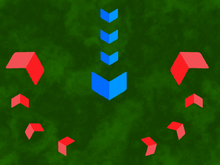Pincer movement




This articlerelies largely or entirely on asingle source.(October 2021) |
Thepincer movement,ordouble envelopment,is amilitary maneuverin which forces simultaneously attack bothflanks(sides) of an enemyformation.This classic maneuver has been important throughout thehistory of warfare.
The pincer movement typically occurs when opposing forces advance towards the center of an army that responds by moving its outside forces to the enemy's flanks to surround it. At the same time, a second layer of pincers may attack the more distant flanks to keep reinforcements from the target units.
Description[edit]
A full pincer movement leads to the attacking army facing the enemy in front, on both flanks, and in the rear. If attacking pincers link up in the enemy's rear, the enemy isencircled.Such battles often end in surrender or destruction of the enemy force, but the encircled force can try tobreak out.They can attack the encirclement from the inside to escape, or a friendly external force can attack from the outside to open an escape route.
History[edit]
The earliest mention of Pincer attack is in a related formation ofPadmavyuhaorChakravyuhain the Indian Epic Mahabharata.
Sun Tzu,inThe Art of War(traditionally dated to the 6th century BC), speculated on the maneuver but advised against trying it for fear that an army would likely run first before the move could be completed. He argued that it was best to allow the enemy a path to escape (or at least the appearance of one), as the target army would fight with more ferocity when surrounded. Still, it would lose formation and be more vulnerable to destruction if shown an avenue of escape.
The maneuver may have first been used at theBattle of Marathonin 490 BC. The historianHerodotusdescribes how the Athenian generalMiltiadesdeployed 900Plataeanand 10,000 Athenianhoplitesin a U-formation with the wings manned much more deeply than the center. His enemyoutnumberedhim heavily, and Miltiades chose to match the breadth of the Persianbattle lineby thinning out the center of his forces while reinforcing the wings. In the course of the battle, the weaker central formations retreated, allowing the wings to converge behind the Persian battle line and drive the more numerous but lightly armed Persians to retreat in panic.
The maneuver was used byAlexander the Greatat theBattle of the Hydaspesin 326 BC. He launched his attack at the Indian left flank, and the Indian kingPorusreacted by sending the cavalry on the right of his formation around in support. Alexander had positioned two cavalry units on the left of his formation, hidden from view, under the command ofCoenusand Demitrius. The units were then able to follow Porus's cavalry around, trapping them in a classic pincer movement.
A famous example of its use was at theBattle of Cannaein 216 BC, whenHannibalexecuted the maneuver against the Romans. Military historians cite it as the first successful use of the pincer movement that was recorded in detail,[1]by the Greek historianPolybius.
It was also later used byKhalid ibn al-Walidat theBattle of Walajain 633, byAlp Arslanat theBattle of Manzikertin 1071 (under the namecrescent tactic) and bySaladinat theBattle of Hattinin 1187.
Genghis Khanused a rudimentary form known colloquially as thehornstactic. Two enveloping flanks of horsemen surrounded the enemy, but they usually remained unjoined, leaving the enemy an escape route to the rear. It was key to many of Genghis's early victories over other Mongolian tribes.
It was used at theBattle of MohácsbySüleyman the Magnificentin 1526 and byField MarshalCarl Gustav Rehnskiöldat theBattle of Fraustadtin 1706.
Even in the horse-and-musket era, the maneuver was used across many military cultures. A double envelopment was deployed by the Iranian conquerorNader Shahat theBattle of Kirkuk (1733)against the Ottomans; the Turco-Persian army, under Nader, flanked the Ottomans on both ends of their line and encircled their centre despite being numerically at a disadvantage. In anotherbattle at Kars in 1745,Nader routed the Ottoman army and subsequently encircled their encampment. The Ottoman army soon after collapsed under the pressure of the encirclement. Also during theBattle of Karnalin 1739, Nader drew out the Mughal army which outnumbered his own force by over six to one, and managed to encircle and defeat a significant contingent of the Mughals in an ambush aroundKunjpuravillage.
Daniel Morganused it at theBattle of Cowpensin 1781 inSouth Carolina.Zuluimpisused a version of the maneuver that they called thebuffalo hornformation.
The maneuver was used in theblitzkriegof the armed forces ofNazi GermanyduringWorld War II,developing into a complex, multidisciplinary endeavor. It involved fast movement by mechanized armor, artillery barrages, air force bombardment, and effective radio communications, with the primary objective of destroying enemycommand and controlchains, undermining enemy troop morale and disrupting supply lines. During theBattle of Kiev (1941)the Axis forces managed to encircle the largest number of soldiers in the history of warfare. Well over half-a-million Soviet soldiers were taken prisoner by the end of the operation.
See also[edit]
References[edit]
- ^"Appendix C"(PDF).The complete book of military science, abridged.Archived fromthe original(PDF file —viewed as cached HTML—)on 2002-01-13.RetrievedMarch 25,2006.
Further reading[edit]
- U.S. Army training manualdiagramArchived2015-07-01 at theWayback Machineof different modes of attack, including double envelopment.
- GlobalSecurity.orgessaywith a section on envelopments.
- Academicpaperon military diagramming with diagram of a double envelopment.
- MapofGeorgy Zhukov's double envelopment at the battle of Stalingrad.
